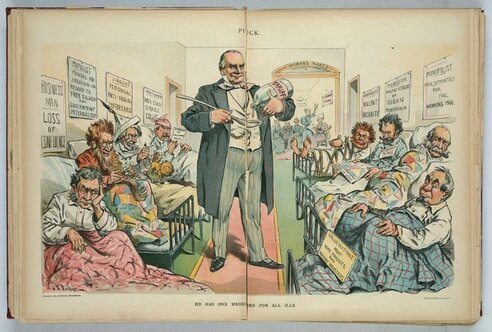Review of government interventions in international trade:
Distribute matching activity and allow students to work in pairs or in small groups to match the government interventions to their definitions, purposes, and effects as follows.
- Tariff
- A tax on imported goods or services
- Intended to protect an industry struggling to compete with foreign companies
- Results in higher prices for both domestic and foreign goods and services and reduces the supply of targeted goods or services
- Embargo
- A policy that forbids trade with a targeted country
- Intended to punish the targeted country for a violation of trade rules or international norms and to convince the targeted country to change domestic policies
- Results in a lack of access to goods and services from the targeted country and diminishes the market in the targeted country for exports
- Standard
- A rule or qualification for goods or services imported into an economy
- Intended to protect health and safety, influence production rules and standards in a foreign country, keep certain goods or services out of the domestic economy
- Results in a reduced supply of foreign goods and services, increased input costs of ensuring goods and services pass inspection, increased cost of inspection regime, and higher prices on domestic and foreign goods and services
- Subsidy
- A payment to the producer of a good or service that lacks comparative advantage
- Intended to make a country’s industry competitive on the global market and drive prices below foreign countries’ ability to produce
- Results in overproduction of targeted goods or services, lower prices for foreign consumers, and higher taxes on domestic taxpayers
- Quota
- A limit on the amount of a good or service that can be imported
- Intended to protect domestic industries from foreign competition when the industry lacks a comparative advantage
- Reduces supply of foreign goods and services and increases prices on foreign and domestic goods and services
Review answers and redistribute letters from Globalization Day 3 to review which countries in Spheradell had which intervention (these letters are attached below). Alternatively, simply review the government interventions from Day 3 without distributing the letters.
- Embargo—Glintopolis
- Quota—Skydell Country
- Standards—Scarlowe Country
- Subsidies—Aberria Country
- Tariffs—Brindlebrook Country
Distribute the Spheradell Gazette Journal article and direct students to read the simulation and respond to these questions:
- “According to the notice above, what issue seems most important to the people of Spheradell? Do you think this reflects the issues that motivate voters in real life?” (The issues most important to the people of Spheradell seem to revolve around their ability to produce and consume Sphere‐Sweet Treats. Answers to the second part of the question may vary, but teachers should take the opportunity to point out the role of economic concerns in elections. People are often motivated by economic issues to vote for one party or the other depending on the perception of future economic success.)
- “The Spheradell Gazette Journal is taking a poll of all prospective voters in Spheradell. Based on the policies of the current leader of your area, are you likely to vote for that leader in the upcoming election? Why or why not?” (Answers will vary.)
- “If you were to challenge the incumbent in your area, how would you convince your fellow citizens to vote for you?” (Answers will vary.)
Inform students that each group will now create an imaginary character to challenge the current leader of their country. Each group will create a poster and a short live advertisement for the candidate. The candidate they create must have the following:
- A poster featuring:
- a name (the more Spheradell‐like the better);
- an image or symbol;
- a motto or slogan (preferably centered on economic concerns);
- a critique of the current leader based on economic interventions that includes the effects on both production and consumption of Sphere‐Sweet Treats; and
- a convincing plan for improving economic conditions. This might include revising economic policies in favor of protectionism or lifting restrictions depending on what the students think will benefit the area most.
- A short, live performance of no more than 1 minute (like a commercial or a speech) that includes:
- the candidate’s name;
- a compelling reason to vote for the candidate;
- a motto or slogan (preferably centered on economic concerns);
- a critique of the current leader based on economic interventions that includes the effects on both production and consumption of Sphere‐Sweet Treats; and a convincing plan for improving economic conditions. This might include revising economic policies in favor of protectionism or lifting restrictions depending on what the students think will benefit the area most.
- Students will be scored based on this rubric:
- The name is creative.
- The image or symbol is interesting and reflects the candidate’s campaign.
- The motto or slogan is compelling and focused on economic concerns.
- The critique of the current candidate is valid and focuses on the ability to produce and consume Sphere‐Sweet Treats.
- The plan is convincing and accurate and could improve economic conditions in your country of Spheradell.
- The poster is attractive and convincing.
- The live performance is engaging and compelling.
- The project shows effort and creativity.
- The overall project indicates a deep understanding of government interventions in trade.
- The overall project indicates cooperation between group members.
Allow groups 20–30 minutes to prepare posters and presentations, depending on how much time is available. Keep in mind that performances will take at least 10 minutes, and you should leave at least 5 minutes for the exit ticket.
Have students present their posters and perform their advertisements and speeches.


![CURRIER & IVES. (CA. 1888) JOHN BULL AND HIS FRIEND CLEVELAND. , CA. 1888. NEW YORK: PUBLISHED BY CURRIER & IVES. [PHOTOGRAPH] RETRIEVED FROM THE LIBRARY OF CONGRESS, https://www.loc.gov/item/2002707675/.](/sites/default/files/styles/container/public/2025-04/cartoon%202.png?itok=H99sVFqZ)